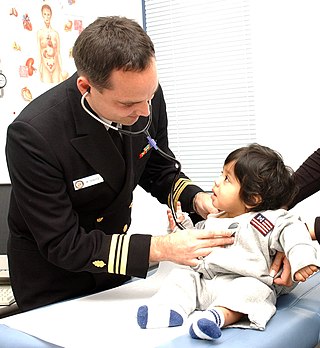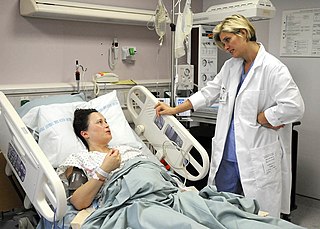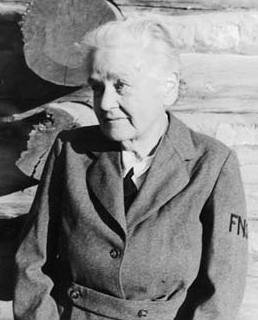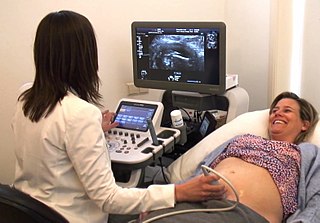Related Research Articles

A registered nurse (RN) is a nurse who has graduated or successfully passed a nursing program from a recognized nursing school and met the requirements outlined by a country, state, province or similar government-authorized licensing body to obtain a nursing license. An RN's scope of practice is determined by legislation, and is regulated by a professional body or council.

The Australian Nursing and Midwifery Federation (ANMF) is the largest union in Australia, with 274,956 members in 2018. The union is run by nurses, midwives and assistants in nursing to advance the industrial, political and professional interests of its members.

A nurse practitioner (NP) is an advanced practice registered nurse and a type of mid-level practitioner. NPs are trained to assess patient needs, order and interpret diagnostic and laboratory tests, diagnose disease, formulate and prescribe medications and treatment plans. NP training covers basic disease prevention, coordination of care, and health promotion.

In the United States, a Certified Nurse-Midwife (CNM) is a nurse midwife who exceeds the International Confederation of Midwives' essential competencies for a midwife and is also an advanced practice registered nurse, having completed registered nursing and midwifery education leading to practice as a nurse midwife and credentialing as a Certified Nurse-Midwife. CNMs provide care of women across their lifespan, including pregnancy and the postpartum period, and well woman care and birth control. Certified Nurse-Midwives are recognized by the International Confederation of Midwives as a type of midwife in the U.S.
Nursing in the United Kingdom has a long history. The current form of nursing is often considered as beginning with Florence Nightingale who pioneered modern nursing. Nightingale initiated formal schools of nursing in the United Kingdom in the late 19th and early 20th centuries. The role and perception of nursing has dramatically changed from that of a handmaiden to the doctor to professionals in their own right. There are over 700,000 nurses in the United Kingdom and they work in a variety of settings, such as hospitals, health centres, nursing homes, hospices, communities, military, prisons, and academia, with most working for the National Health Service (NHS). Nurses work across all demographics and requirements of the public: adults, children, mental health, and learning disability. Nurses work in a range of specialties from the broad areas of medicine, surgery, theatres, and investigative sciences such as imaging. Nurses also work in large areas of sub-specialities such as respiratory, diabetes, cancer, neurology, infectious diseases, liver, research, cardiac, women's health, sexual health, emergency and acute care, gastrointestinal, infection prevention and control, neuroscience, ophthalmic, pain and palliative, and rheumatology. Nurses often work in multi-disciplinary teams but increasingly are found working independently.

The Frontier Nursing Service (FNS) provides healthcare services to rural, underserved populations since 1925, and educates nurse-midwives since 1939.

Mary Carson Breckinridge was an American nurse midwife and the founder of the Frontier Nursing Service (FNS), which provided comprehensive family medical care to the mountain people of rural Kentucky. FNS served remote and impoverished areas off the road and rail system but accessible by horseback. She modeled her services on European practices and sought to professionalize American nurse-midwives to practice autonomously in homes and decentralized clinics. Although Breckinridge's work demonstrated efficacy by dramatically reducing infant and maternal mortality in Appalachia, at a comparatively low cost, her model of nurse-midwifery never took root in the United States.

Nursing in Australia has evolved in training and regulation since the 19th century.
Dr Rhodanthe Grace Lipsett OAM was an Australian midwife and author. Throughout her professional life she specialised in infant and maternal health.

Nursing is a profession within the healthcare sector focused on the care of individuals, families, and communities so they may attain, maintain, or recover optimal health and quality of life. Nurses can be differentiated from other healthcare providers by their approach to patient care, training, and scope of practice. Nurses practice in many specialties with differing levels of prescription authority. Nurses comprise the largest component of most healthcare environments; but there is evidence of international shortages of qualified nurses. Nurses collaborate with other healthcare providers such as physicians, nurse practitioners, physical therapists, and psychologists. There is a distinction between nurses and nurse practitioners; in the U.S., the latter are nurses with a graduate degree in advanced practice nursing, and are permitted to prescribe medications unlike the former. They practice independently in a variety of settings in more than half of the United States. Since the postwar period, nurse education has undergone a process of diversification towards advanced and specialized credentials, and many of the traditional regulations and provider roles are changing.
Flora Jean Cameron was a New Zealand nurse, nursing instructor and administrator.
The timeline of nursing history in Australia and New Zealand stretches from the 19th century to the present.
Mary Francis Hill Coley was an American lay midwife who ran a successful business providing a range of birth services and who starred in a critically acclaimed documentary film used to train midwives and doctors. Her competence projected an image of black midwives as the face of an internationally esteemed medical profession, while working within the context of deep social and economic inequality in health care provided to African Americans. Her life story and work exist in the context of Southern granny midwives who served birthing women outside of hospitals.

A midwife is a health professional who cares for mothers and newborns around childbirth, a specialization known as midwifery.

A nurse midwife is both a nurse and a midwife, having completed nursing and midwifery education leading to practice as a nurse midwife and sometimes credentialed in the specialty. Nurse midwives provide care of women across the lifespan, including during pregnancy and the postpartum period, and well woman care and birth control.
Suzanne Judith Denison OAM, née Brown is an Australian nurse practitioner based in the rural New South Wales town of Nundle. Together with Jane O'Connell, she was one of the first two authorised Nurse Practitioners in Australia.
The Congress of Aboriginal and Torres Strait Islander Nurses and Midwives (CATSINaM) is the peak national body that represents, advocates for, and supports Aboriginal and Torres Strait Islander nurses and midwives in Australia.
Margaret (Maggie) Fraser Myles, née Findlay, was a Scottish midwife, midwifery tutor and lecturer and author. She is globally known for her Textbook for Midwives, first published in 1953, which has been considered a reference midwifery textbook for decades.
Caroline Susan E. Homer is an Australian midwifery researcher and international advocate for women's health rights. She is Co-Program Director, Maternal and Child Health at the Burnet Institute in Melbourne and Visiting Distinguished Professor of Midwifery at the University of Technology Sydney.

Mary Kirkpatrick was a pioneer of women's healthcare and the first trained midwife on the Mid North Coast of New South Wales. She established the first private maternity hospital, eventually establishing three more. Kirkpatrick worked with and mentored many of midwives and nurses who followed her to the coast.
References
- ↑ "Honouring the people of North Sydney". The Mosman Daily. Retrieved 29 August 2021.
- ↑ "The Year that Made Me: Mary Chiarella, 2001". ABC Radio National. 11 July 2021. Retrieved 29 August 2021.
- ↑ "Curriculum Vitae of Mary Chiarella". Sydney University. Retrieved 31 August 2021.
- ↑ "The Year that Made Me: Mary Chiarella, 2001". ABC Radio National. 11 July 2021.
- ↑ "Staff Profile". The University of Sydney. Retrieved 29 August 2021.
- ↑ Chiarella, Mary. "We make the road by walking Nurse Practitioner Models of Care" (PDF). Retrieved 29 August 2021.
- ↑ "Close-Up: Professor Mary Chiarella – Informa Australia" . Retrieved 29 August 2021.
- ↑ "HEALTH MINISTERS ANNOUNCE APPOINTMENTS TO NATIONAL BOARDS FOR THE NATIONAL REGISTRATION AND ACCREDITATION SCHEME". Australian Health Workforce Ministerial Council. Retrieved 29 August 2021.
- ↑ "Australian nursing and midwifery council annual report 09/10" (PDF). Retrieved 29 August 2021.
- ↑ STAUNTON, PATRICIA; CHIARELLA, MARY (2020). LAW FOR NURSES AND MIDWIVES. [Place of publication not identified]: ELSEVIER AUSTRALIA. ISBN 9780729543484.
- ↑ Chiarella, Mary (2002). The legal and professional status of nursing. Edinburgh: Churchill Livingstone. ISBN 9780443071911.
- ↑ Chiarella, Mary (2006). Policy in end-of-life care : education, ethics, practice and research. London: Quay Books. ISBN 1856423077.
- ↑ Adrian, Amanda; Chiarella, Mary (2010). Professional conduct : a case book of decisions relating to professional conduct matters (2nd ed.). Sydney, N.S.W.: Nurses and Midwives Board of New South Wales. ISBN 9780980801903.
- ↑ Chiarella, Mary; Keatinge, Diana (2001). Professional Conduct:A case book of disciplinary decisions relating to professional conduct matters. New South Wales Government - Nurses Registration Board of New South Wales. ISBN 0731397487.
- ↑ "Staff Profile". The University of Sydney.
- ↑ "The Drum - ABC". Twitter.
- ↑ "The Year that Made Me: Mary Chiarella, 2001". ABC Radio National. ABC Radio National. 11 July 2021. Retrieved 29 August 2021.